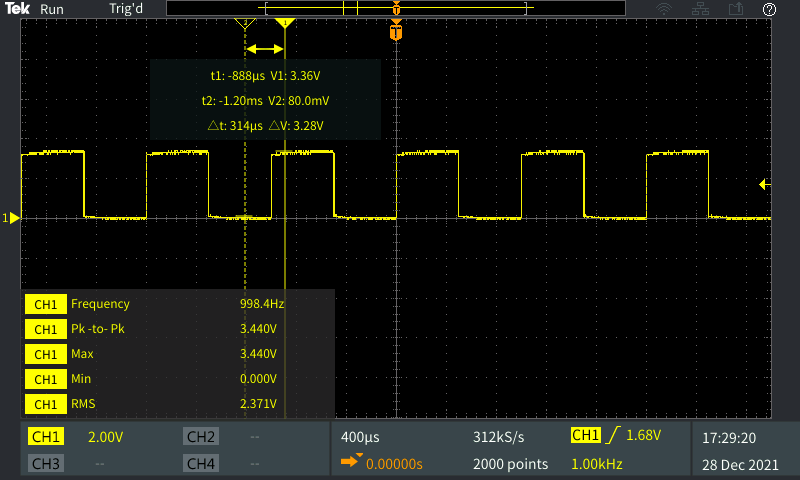Table of Contents
PWM
Introduction
This page introduces the usage of hardware PWM, and leads you to control the hardware PWM on the 40-Pin Header.
PWM Reference Table
| PWM | PIN | GPIO name | DT overlay node | Device node | |
|---|---|---|---|---|---|
| VIM1 | PWM_AO_A | 35 | GPIOAO_3 | pwm_ao_a | /sys/class/pwm/pwmchip4 |
| VIM2 | PWM_D | 35 | GPIODV_28 | pwm_d | /sys/class/pwm/pwmchip1 |
| VIM3 | PWM_F | 35 | GPIOH_5 | pwm_f | /sys/class/pwm/pwmchip4 |
| VIM3L | PWM_F | 35 | GPIOH_5 | pwm_f | /sys/class/pwm/pwmchip0 |
| VIM4 | PWM_F | 35 | GPIOY_8 | pwm_f | /sys/class/pwm/pwmchip4 |
| VIM1S | PWM_F | 35 | GPIOZ_6 | pwm_f | /sys/class/pwm/pwmchip0 |
Enable PWM
Linux
In order to use the PWM, you need to enable the PWM function via Device Tree Overlay.
VIM1/2/3/Edge1
Edit /boot/env.txt to add the pwm node to overlays node if it doesn't exist.
Take VIM3 as an example to enable PWM_F, you need to add pwm_f node to overlays node if it doesn't exist.
overlays=uart3 pwm_f i2c3 i2s os08a10 watchdog
After reboot, you will see the pwm device node.
$ ls /sys/class/pwm/pwmchip4
device export npwm power subsystem uevent unexport
VIM3L
Edit /boot/env.txt to add the pwm node to overlays node if it doesn't exist.
Take VIM3L as an example to enable PWM_F, you need to add pwm_f node to overlays node if it doesn't exist.
overlays=uart3 pwm_f i2c3 i2s watchdog
After reboot, you will see the pwm device node.
$ ls /sys/class/pwm/pwmchip0
device export npwm power subsystem uevent unexport
VIM3 with 5.15 kernel
Edit /boot/dtb/amlogic/kvim3.dtb.overlay.env to add pwm node to fdt_overlays node if it doesn't exist.
You need to add pwm_f to node fdt_overlays if it doesn't exist to enable PWM_F.
fdt_overlays=pwm_f
After reboot, you will see the pwm device node.
VIM3L with 5.15 kernel
Edit /boot/dtb/amlogic/kvim3l.dtb.overlay.env to add pwm node to fdt_overlays node if it doesn't exist.
You need to add pwm_f to node fdt_overlays if it doesn't exist to enable PWM_F.
fdt_overlays=pwm_f
After reboot, you will see the pwm device node.
VIM4
Edit /boot/dtb/amlogic/kvim4.dtb.overlay.env to add pwm node to fdt_overlays node if it doesn't exist.
You need to add pwm_f to node fdt_overlays if it doesn't exist to enable PWM_F.
fdt_overlays=pwm_f
After reboot, you will see the pwm device node.
$ ls /sys/class/pwm/pwmchip4
device export npwm power subsystem uevent unexport
VIM1S
Edit /boot/dtb/amlogic/kvim1s.dtb.overlay.env to add pwm node to fdt_overlays node if it doesn't exist.
You need to add pwm_f to node fdt_overlays if it doesn't exist to enable PWM_F.
fdt_overlays=pwm_f
After reboot, you will see the pwm device node.
$ ls /sys/class/pwm/pwmchip0
device export npwm power subsystem uevent unexport
Android
VIM4
The PWM function is disabled by default, you need to modify the dts to enable it.
diff --git a/arch/arm64/boot/dts/amlogic/kvim4.dts b/arch/arm64/boot/dts/amlogic/kvim4.dts --- a/arch/arm64/boot/dts/amlogic/kvim4.dts +++ b/arch/arm64/boot/dts/amlogic/kvim4.dts &pwm_ef { + pinctrl-names = "default"; + pinctrl-0 = <&pwm_f_pins>; status = "okay"; }; diff --git a/arch/arm64/boot/dts/amlogic/kvim4n.dts b/arch/arm64/boot/dts/amlogic/kvim4n.dts --- a/arch/arm64/boot/dts/amlogic/kvim4n.dts +++ b/arch/arm64/boot/dts/amlogic/kvim4n.dts &pwm_ef { + pinctrl-names = "default"; + pinctrl-0 = <&pwm_f_pins>; status = "okay"; }; diff --git a/arch/arm64/boot/dts/amlogic/mesont7_an400-panel.dtsi b/arch/arm64/boot/dts/amlogic/mesont7_an400-panel.dtsi --- a/arch/arm64/boot/dts/amlogic/mesont7_an400-panel.dtsi +++ b/arch/arm64/boot/dts/amlogic/mesont7_an400-panel.dtsi @@ -1442,13 +1442,13 @@ backlight1{ compatible = "amlogic, backlight-t7"; - status = "okay"; + status = "disabled"; index = <1>; key_valid = <0>; pinctrl-names = "pwm_on", "pwm_off"; - pinctrl-0 = <&pwm_f_pins>; - pinctrl-1 = <&bl1_pwm_off_pins>; pinctrl_version = <2>; /* for uboot */ interrupts = <0 197 1
VIM1S
The PWM function is disabled by default, you need to modify the dts to enable it.
--- a/arch/arm64/boot/dts/amlogic/kvim1s.dts +++ b/arch/arm64/boot/dts/amlogic/kvim1s.dts @@ -1411,8 +1411,8 @@ }; &pwm_ef { - /*pinctrl-0 = <&pwm_f_pins2>;*/ - /*pinctrl-names = "default";*/ + pinctrl-0 = <&pwm_f_pins2>; + pinctrl-names = "default"; status = "okay"; };
Control PWM
Enable PWM:
VIM1/3/4
echo 1 | sudo tee /sys/class/pwm/pwmchip4/export echo 1000000 | sudo tee /sys/class/pwm/pwmchip4/pwm1/period echo 500000 | sudo tee /sys/class/pwm/pwmchip4/pwm1/duty_cycle echo 1 | sudo tee /sys/class/pwm/pwmchip4/pwm1/enable
VIM2
echo 1 | sudo tee /sys/class/pwm/pwmchip1/export echo 1000000 | sudo tee /sys/class/pwm/pwmchip1/pwm1/period echo 500000 | sudo tee /sys/class/pwm/pwmchip1/pwm1/duty_cycle echo 1 | sudo tee /sys/class/pwm/pwmchip1/pwm1/enable
VIM3L/1S
echo 1 | sudo tee /sys/class/pwm/pwmchip0/export echo 1000000 | sudo tee /sys/class/pwm/pwmchip0/pwm1/period echo 500000 | sudo tee /sys/class/pwm/pwmchip0/pwm1/duty_cycle echo 1 | sudo tee /sys/class/pwm/pwmchip0/pwm1/enable
Use an oscilloscope to check if the pins have been successfully enabled.
If you use an oscilloscope to view the PWM waveform, remember that the SBC and the oscilloscope need to share the same GND (ground).
Disable PWM:
VIM1/3/4
echo 0 | sudo tee /sys/class/pwm/pwmchip4/pwm1/enable
VIM2
echo 0 | sudo tee /sys/class/pwm/pwmchip1/pwm1/enable
VIM3L/1S
echo 0 | sudo tee /sys/class/pwm/pwmchip0/pwm1/enable
Disable PWM to Use GPIO
If you want to use normal GPIO instead of PWM, you can remove the PWM node in Device Tree Overlay.
